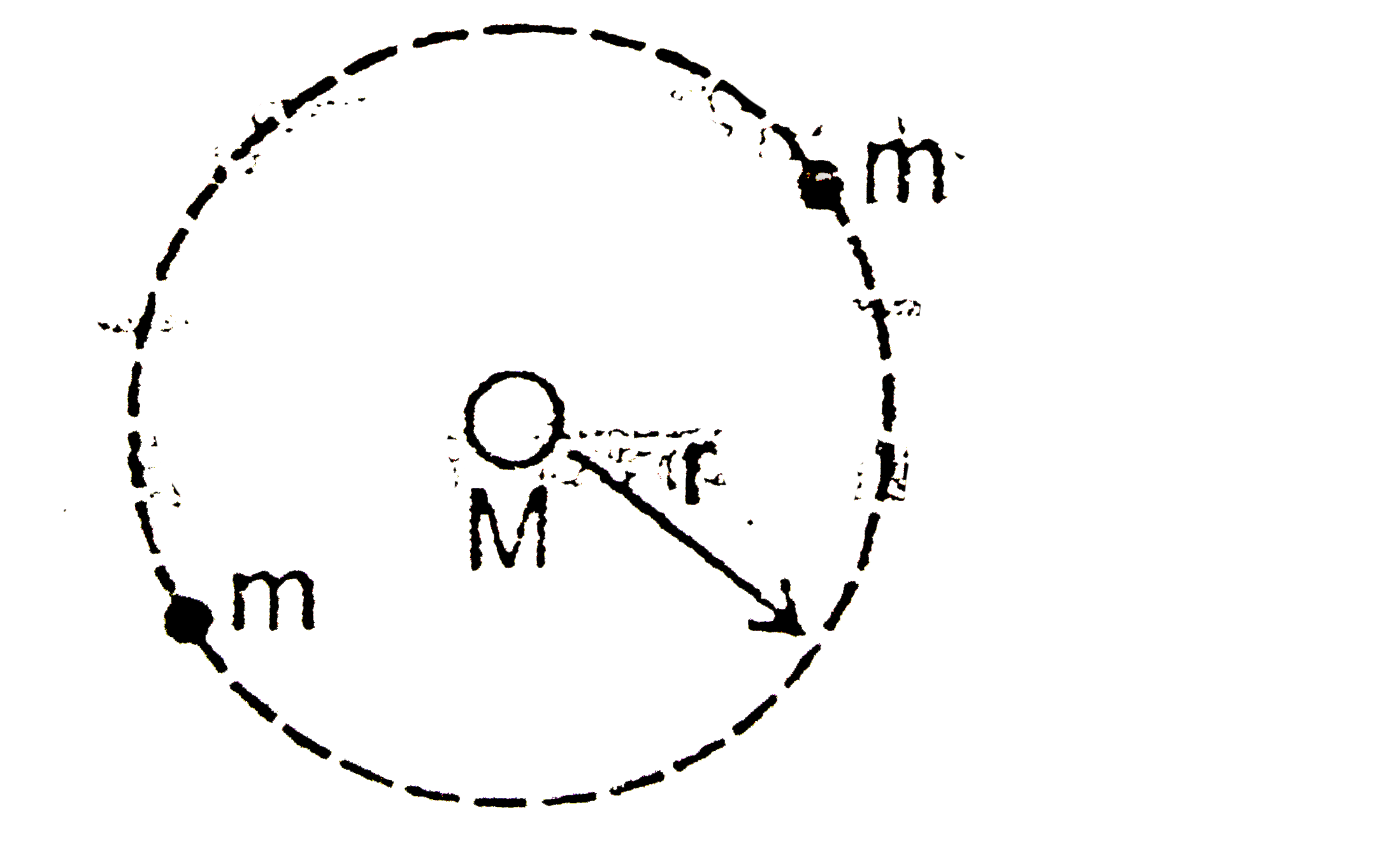If two bodies of mass M and m are revolving around the centre of mass of the system in circular orbits of radii R and r respectively due to mutual interaction. Which of the following formulee is applicable ?
GMm(R+r)2=mω2r
GMmR2=mω2r
GMmr2=mω2R
GMmR2+r2=mω2r
The correct Answer is:A
To solve the problem of two bodies of mass M and m revolving around their center of mass in circular orbits of radii R and r respectively, we can follow these steps:
1. Identify the System:
We have two masses, M and m, revolving around their center of mass. The distances from the center of mass to the masses are R (for mass M) and r (for mass m).
2. Understand the Center of Mass:
The center of mass (CM) of the two-body system is given by the formula:
RCM=M⋅R+m⋅rM+m
However, for the purpose of this problem, we will focus on the forces acting on the masses.
3. Centripetal Force Requirement:
Each mass experiences a centripetal force that keeps it in circular motion. The centripetal force FC for mass M is given by:
FCM=M⋅ω2⋅R
and for mass m:
FCm=m⋅ω2⋅r
where ω is the angular velocity of the system.
4. Gravitational Force:
The gravitational force FG between the two masses is given by Newton's law of gravitation:
FG=G⋅M⋅m(R+r)2
where G is the gravitational constant.
5. Equating Forces:
The centripetal force required for each mass is provided by the gravitational force. Therefore, we can set up the following equations:
For mass M:
G⋅M⋅m(R+r)2=M⋅ω2⋅R(1)
For mass m:
G⋅M⋅m(R+r)2=m⋅ω2⋅r(2)
6. Final Formulation:
From equation (1), we can express the gravitational force in terms of centripetal force for mass M:
G⋅M⋅m(R+r)2=M⋅ω2⋅R
This can be rearranged to:
G⋅M⋅m(R+r)2=M⋅ω2⋅R
Thus, we find that:
G⋅M⋅m(R+r)2=m⋅ω2⋅r
7. Identifying the Correct Formula:
The correct formula that applies to the system is:
G⋅M⋅m(R+r)2=M⋅ω2⋅R
This indicates that the gravitational force equals the centripetal force for both masses.
Conclusion:
The applicable formula for the system of two bodies revolving around their center of mass is:
G⋅M⋅m(R+r)2=M⋅ω2⋅R
We have two masses, M and m, revolving around their center of mass. The distances from the center of mass to the masses are R (for mass M) and r (for mass m).
The center of mass (CM) of the two-body system is given by the formula:
RCM=M⋅R+m⋅rM+m
However, for the purpose of this problem, we will focus on the forces acting on the masses.
Each mass experiences a centripetal force that keeps it in circular motion. The centripetal force FC for mass M is given by:
FCM=M⋅ω2⋅R
and for mass m:
FCm=m⋅ω2⋅r
where ω is the angular velocity of the system.
The gravitational force FG between the two masses is given by Newton's law of gravitation:
FG=G⋅M⋅m(R+r)2
where G is the gravitational constant.
The centripetal force required for each mass is provided by the gravitational force. Therefore, we can set up the following equations:
For mass M:
G⋅M⋅m(R+r)2=M⋅ω2⋅R(1)
For mass m:
G⋅M⋅m(R+r)2=m⋅ω2⋅r(2)
From equation (1), we can express the gravitational force in terms of centripetal force for mass M:
G⋅M⋅m(R+r)2=M⋅ω2⋅R
This can be rearranged to:
G⋅M⋅m(R+r)2=M⋅ω2⋅R
Thus, we find that:
G⋅M⋅m(R+r)2=m⋅ω2⋅r
The correct formula that applies to the system is:
G⋅M⋅m(R+r)2=M⋅ω2⋅R
This indicates that the gravitational force equals the centripetal force for both masses.
The applicable formula for the system of two bodies revolving around their center of mass is:
G⋅M⋅m(R+r)2=M⋅ω2⋅R
Topper's Solved these Questions
- GRAVITATIONBook:ALLENChapter:GRAVITATIONExercise:EXERCISE 2
Explore 26 Videos
- GRAVITATIONBook:ALLENChapter:GRAVITATIONExercise:EXERCISE 3
Explore 11 Videos
- GRAVITATIONBook:ALLENChapter:GRAVITATIONExercise:BOX-4
Explore 14 Videos
- GEOMETRICAL OPTICSBook:ALLENChapter:GEOMETRICAL OPTICSExercise:subjective
Explore 14 Videos
- KINEMATICS-2DBook:ALLENChapter:KINEMATICS-2DExercise:Exercise (O-2)
Explore 46 Videos
Similar Questions
Two satellites of masses of m1 and m2(m1>m2) are revolving round the earth in circular orbits of radius r1 and r2(r1>r2) respectively. Which of the following statements is true regarding their speeds v1 and v2?
View SolutionA sayellite of mass m revolves in a circular orbit of radius R a round a planet of mass M. Its total energy E is :-
View Solution
Knowledge Check
Two particles of equal masses are revolving in circular paths of radii, r1andr2 respectively with the same period . The ratio of their centripetal force is -
Ar1/r2B√r2/r1C(r1/r2)2D(r2/r1)2Two stars of masses m1 and m2 distance r apart, revolve about their centre of mass. The period of revolution is :
A2π√r32G(m1+m2)B2π√r3(m1+m2)2G(m1m2)C2π√2r3G(m1+m2)D2π√r3G(m1+m2)
Two satellites P and Q ratio of masses 3:1 are in circular orbits of radii rand8r. Then ratio of total mechanical energy of A to B is
View SolutionTwo satellite A and B, ratio of masses 3:1 are in circular orbits of radii rand4r. Then ratio mechanical energy of A and B is
View SolutionTwo satellite A and B , ratio of masses 3:1 are in circular orbits of radii r and 4 r . Then ratio of total mechanical energy of A to B is
View Solution_E01_055_Q01.png)
For the double star system, the two stars having masses m1 and m2are separated b a distance r. They are revolving about their common centre of mass in radii r1 and r2 respectively. Which of the following is/are incorrect.?
View SolutionTwo stars of masses m1 and m2 distance r apart, revolve about their centre of mass. The period of revolution is :
View SolutionAn isolated triple star systerm consists of two identical stars, each of mass m and f fixed star of mass M. They revolve around the central star in the same circular orbit to radius r. The orbiting stars are always at opposite ends of a diameter of the orbit. The time period of revolution of each star around the fixed is equal to:

View Solution
